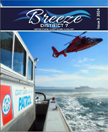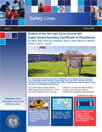News and Articles
 |
The Auxiliarist eMagazine - 1st Quarter 2025The national publication of the U.S. Coast Guard AuxiliaryThe Auxiliarist Editorial Team and the Publications Division of the Public Affairs Directorate remain committed to providing Auxiliarists with the latest happenings across the nation, keeping you updated through our stories to stay Semper Paratus. |
 |
District 7 - Breeze Newsletter (Fall 2024)Your District 7 publications team invites you to view the latest issue of the Breeze Newsletter We hope everyone remains safe and healthy in these ever-changing times. As always, thank you for your continued support and we look forward to sharing more exciting District 7 updates in the months to come. |
 |
The BAGGYWRINKLEU.S. Coast Guard Auxiliary 7th District – Division 2
|
 |
Safety Lines Newsletter Winter/Spring 2025The Winter/Spring 2025 issue of Safety Lines, the Prevention Directorate newsletter, is now available online. This issue features a variety of Prevention topics including:
Click here to view this edition of Safety Lines. |
The Float Plan – It takes the ‘Search’ out of Search & Rescue
Search and Rescue (SAR) is a term used by the Coast Guard, and others, to name the exercise when a boat is overdue and presumed in jeopardy. Of the two words, the Search part of a SAR is the most difficult. If you can’t be found, rescue won’t happen. Rescue can be relatively easy, well maybe not in Alaska. Certainly, on our lake it is not a difficult task.
So, how do we take the “Search” out of Search and Rescue. It’s easy! We prepare a Float Plan prior to departure. The plan need not be overly complicated but should cover the following points:
· Description of the boat, type, length, color, with its registration number and name – like “the Lindy Loop”.
· A description of your car, it’s license number and what marina or launch ramp it is parked.
· Number of people on board.
· Where are you leaving from.
· When are you leaving.
· Where are you going.
· Your route there.
· When you expect to return and where.
· Do you have a marine radio.
· Your cell phone number.
· Who is your contact on shore and phone number.
· What to do if you don’t return as scheduled.
This next part is very important. The Coast Guard or other agencies do not take your plan. They do the rescue part. Leave the float plan with a good friend, that you can trust to act once you are ‘overdue’. Your friend should then call the appropriate party to come to your rescue. The appropriate party could be a friend with a boat, the Corps of Engineers, or the DNRs. You can print up a short float plan with the above information either pre-entered or completed just prior to the trip. The float plan tells the rescuer just where to look.
If this still seems just too much, just tell someone where you are leaving from and when you will be returning and what to do if you are ‘overdue’. Another good idea if you are leaving your vehicle in the parking lot of the ramp area, is to leave the name and number of your float plan buddy on the dashboard visible thru the windshield. This gives searchers an immediate contact.
No matter how you file your float plan, there is one huge responsibility on your part. You MUST cancel your float plan at the completion of your cruise. If you don’t, rescue operations will start and can waste a good deal of time and money, while you are safe and sound having dinner at your favorite restaurant.
Use this link to access a Coast Guard site with float plan formats and information on how to create them. The formats are downloadable, http://floatplancentral.cgaux.org/